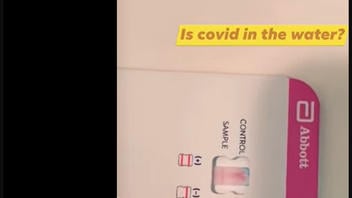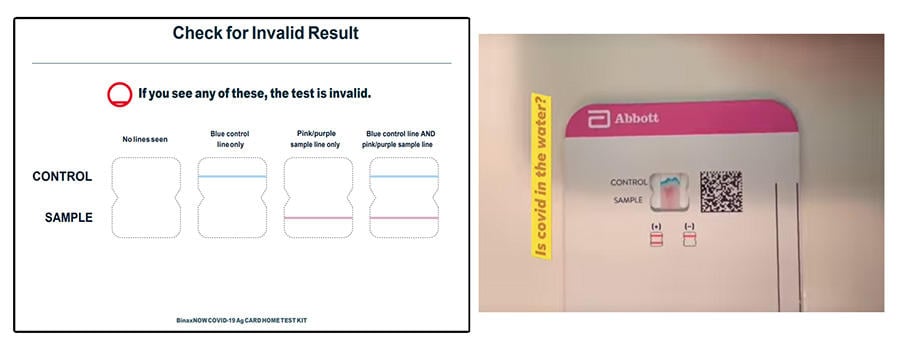
Did a woman find that there was evidence of SARS-CoV-2 in tap water because she tested the water with a COVID-19 home test kit? No, that's not true: The reading at the end of the video shows an invalid test result, not a positive COVID result. The test was performed incorrectly, outside of the manufacturer's labeling instructions and intended purpose. This test is only intended to detect the viral protein antigen of SARS-CoV-2 from a nasal swab sample. This test kit is not designed to test water or food for the presence of SARS-CoV-2.
This video was posted on Facebook (archived here) on December 27, 2021. The caption in the video reads, "Is covid in the water?" The caption posted with the video had many engagement-boosting hashtags unrelated to COVID-19 or testing:
Is #covid #omicron in the #water #instagram #youtube #twitter #tiktok #love #instagood #follow #like #socialmedia #whatsapp #music #google #photography #memes #marketing #india #followforfollowback #likeforlikes #a #insta #fashion #trending #digitalmarketing #covid #o #snapchat #socialmediamarketing #Hbd #motivation #fitness #inspiration #love #life #lifestyle #motivationalquotes #instagood #quotes #success #workout #instagram #gym #goals #mindset #positivevibes #fitnessmotivation #happy #fit #follow #selflove #bhfyp #training #happiness #believe #like #entrepreneur #bodybuilding #inspirationalquotes #bhfyp
This is how the video appeared on Facebook at the time of writing:
(Image source: Facebook screenshot taken on Wed Dec 29 17:58:34 2021 UTC)
The test pictured in this video appears to be a BinaxNOW COVID-19 Ag Card Home Test. It is impossible to know exactly how this at-home test kit was used or what the sample may have contained because there was an editing cut between when the swab was soaked under running tap water and when the test result window was shown. The person in the video seems to be excited and upset that the colors they see are dark after "only using water."
When this test is used according to instructions, there is a blue control line in the result window before the test is used. A small dropper bottle of an extraction reagent is included in the test kit, and only six drops of this fluid are used to prepare the test card. If the test is conducted properly, the control line will change from blue to pink. If the test has a positive COVID result, a second pink line will appear under the control line in the results window. If the test did not detect the specific viral antigens there will not be any trace of a second line in the results window.
Below is a diagram from a home test kit user guide showing four possible ways an invalid test result could appear on the Abbott BinaxNOW COVID-19 Ag Card. This diagram can be compared to a screenshot from the video that was posted on Facebook. The results window from the video, showing both blue and pink colors bleeding across the test strip is clearly an invalid result. Directly below the results window on the test card are diagrams showing how a positive and negative test result would appear on a properly conducted test.
(Image source: Lead Stories composite image with coronavirus.ohio.gov and Facebook screenshots taken on Wed Dec 29 19:40:20 2021 UTC)
Lead Stories reached out by email to Abbott, the maker of the BinaxNOW COVID-19 test kit, to find out if the kit can be used to test water samples in this way. The director of public affairs in the rapid diagnostics division, John M. Koval, responded with this statement from Abbott on December 29, 2021:
BinaxNOW is for use with samples collected with a nasal swab inserted into a person's nostrils. BinaxNOW is not for use with water or any other foods or liquids. When used as intended, it is a highly accurate test that is helping to detect COVID-19 and can significantly improve efforts to control transmission. Spreading misinformation with deliberate misuse of a medical product during a pandemic is misleading, irresponsible and dangerous to public health. Other liquids have chemical properties which can cause a chemical reaction on the test strip, resulting in misleading or inaccurate results. Failure to follow the instructions for the test procedure and interpretation of test results may adversely affect test performance and produce misleading or invalid results.















